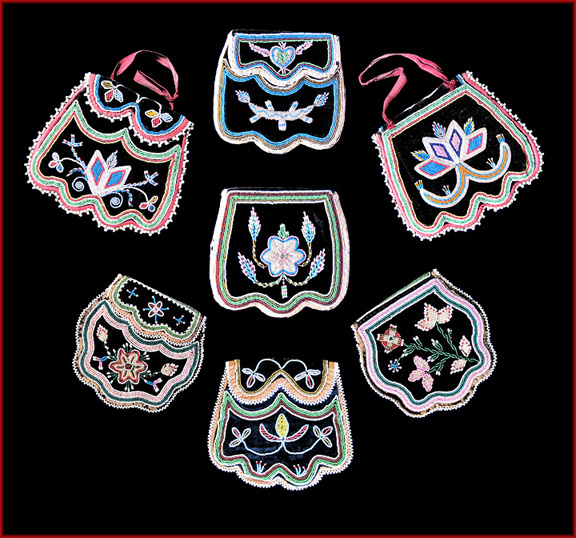The beaded bag Caroline Parker (a Seneca from the Tonawanda Reservation in Western New York) is holding in a late 1840s Daguerreotype is virtually identical to the one illustrated in Plate 11 of Lewis Henry Morgan’s 1850 report to the Regents of the State University of New York.
Morgan acquired an outfit from her in 1849, which consisted of beaded moccasins, skirt, blanket, leggings, overdress and a handbag, which the State Museum in Albany says were items “which she herself had made.” Occasionally, beaded bags in this style are seen in both museum and private collections. They usually have a scalloped flap and a scalloped lower edge, as well as several strings of beads sewn in a tight band along the perimeter. Caroline (known as Carrie to her friends and family) may have developed the beading style on these bags. On the other hand, her mother Elizabeth Parker was also known for her beading skills and this style might also be attributed to her. Morgan’s correspondence with the Parkers indicates that payments for items supplied to the Cabinet of State were made to Caroline and her brother Nicholson. Other Seneca women may have also assisted in producing beadwork for the Cabinet of State. Arthur Parker, Caroline’s nephew, mentions a “What-Not” or curio cabinet that her mother Elizabeth kept at the family farm. One shelf contained a display of “fancy Indian beadwork,” presumably made by her mother, but there is no description of it (Parker 1919:194). Parker also mentions that Elizabeth, who was Red Jacket niece, “made very fine bead-work too and Aunt Carrie learned from her” (Parker 1919:235). The scalloping technique along the edge of these bags may have originated in response to the Victorians’ love for scalloped borders. It’s rare to find a Haudenosaunee bag with scalloped edges that predates the Victorian era.
Morgan, Lewis Henry
1850 Third Annual Report of the Regents of the University on the Condition of the State Cabinet of Natural History and Antiquarian Collection, Annexed Thereto. Revised Edition: Printed by Weed, Parsons and Company, Albany.
Parker, Arthur C. 1919 The Life of General Ely S. Parker, Last Grand Sachem of the Iroquois and General Grant’s Military Secretary. Published by the Buffalo Historical Society, Buffalo, New York.
